filter
-
Brand
- By Category
- Direction
- Date Range
98Events
Pictures
Events
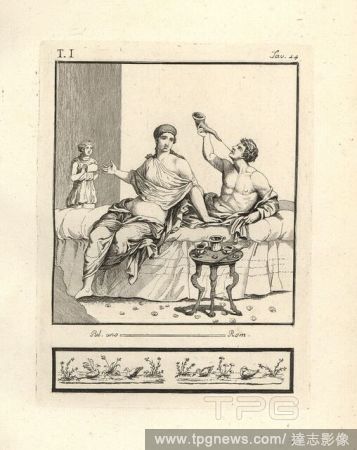
Editorial
- 2023-06-15
- 1
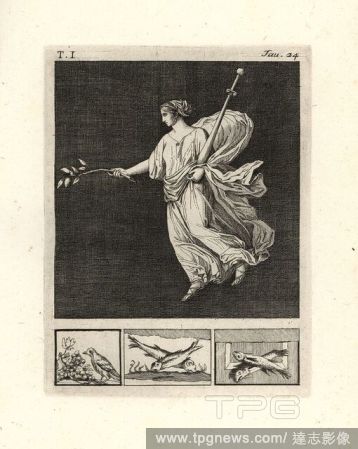
Editorial
- 2023-06-15
- 1
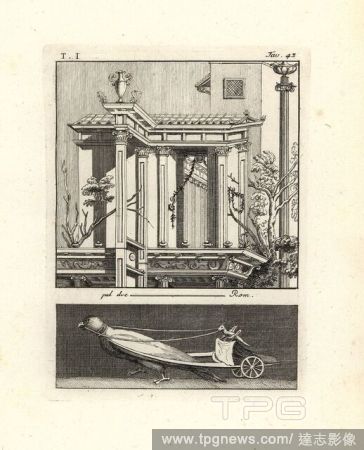
Editorial Architectural painting of an Ionic portico, with a cornice decorated with dolphins and tritons, and an entablature with vase. Perhaps a Coenaculum, the upper room on a country house. Vignette below shows a parrot pulling a cricket in a chariot. Copperp...
- 2022-07-22
- 1
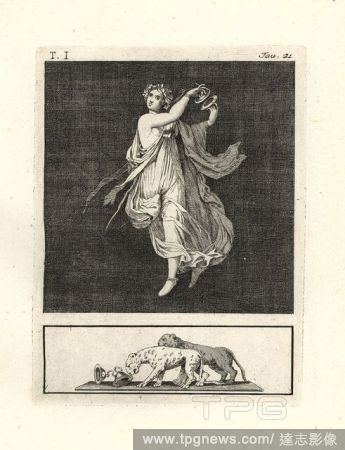
Editorial Painting removed from a wall of a room, possibly a triclinium or dining room, in a house in Pompeii in 1749. It shows a bacchant dancer striking cymbals together. She wears a wreath of ivy, a necklace and bracelets, and a fine blue robe covered with an...
- 2022-01-18
- 1
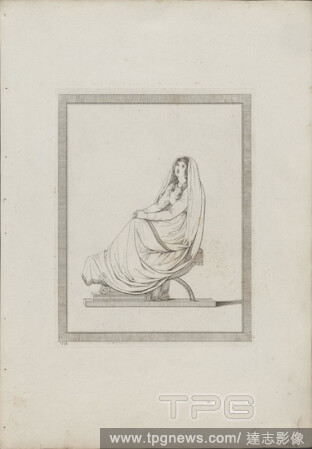
Editorial Plate VII, still image, Prints, 1794, Rehberg, Friedrich, 1758-1835, Piroli, Tommaso, approximately 1752-1824.
- 2021-04-07
- 1
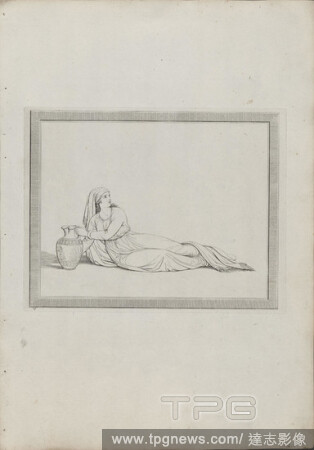
Editorial Plate V, still image, Prints, 1794, Rehberg, Friedrich, 1758-1835, Piroli, Tommaso, approximately 1752-1824.
- 2021-04-07
- 1
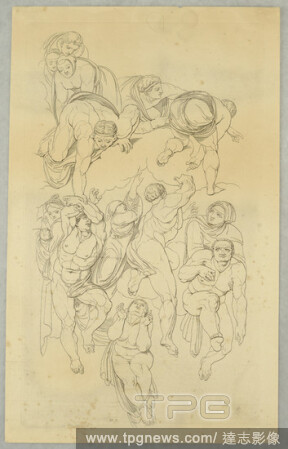
Editorial Plate, from Le Jugement Universal, Tommaso Piroli, Italian, 1752 - 1824, Michelangelo Buonarroti, Italian, 14751564, Etching on paper, Plate 7, Europe, 1808, Print, Print.
- 2021-02-22
- 1
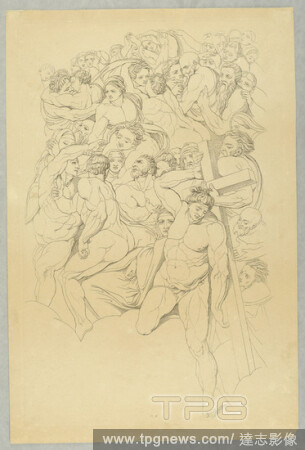
Editorial Plate, from Le Jugement Universal, Tommaso Piroli, Italian, 1752 - 1824, Michelangelo Buonarroti, Italian, 14751564, Etching on paper, Plate 9, Europe, 1808, Print, Print.
- 2021-02-22
- 1
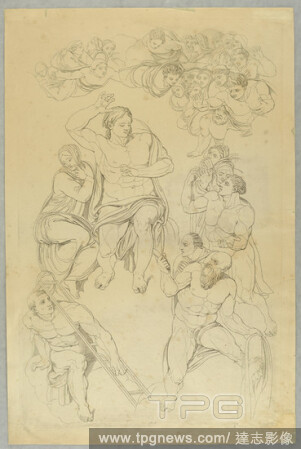
Editorial Plate, from Le Jugement Universal, Tommaso Piroli, Italian, 1752 - 1824, Michelangelo Buonarroti, Italian, 14751564, Etching on paper, Plate 5, Europe, 1808, Print, Print.
- 2021-02-22
- 1

Editorial Plate, from Le Jugement Universal, Tommaso Piroli, Italian, 1752 - 1824, Michelangelo Buonarroti, Italian, 14751564, Etching on paper, Plate 10, Europe, 1808, Print, Print.
- 2021-02-22
- 1
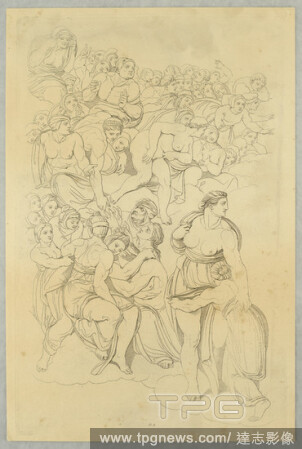
Editorial Plate, from Le Jugement Universal, Tommaso Piroli, Italian, 1752 - 1824, Michelangelo Buonarroti, Italian, 14751564, Etching on paper, Plate 8, Europe, 1808, Print, Print.
- 2021-02-21
- 1
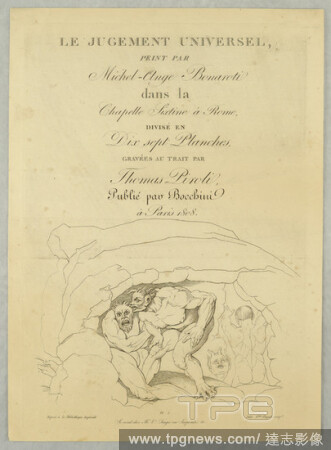
Editorial Cover Page, Le Jugement Universel, Tommaso Piroli, Italian, 1752 - 1824, Michelangelo Buonarroti, Italian, 14751564, Etching on paper, Plate 1 Le Jugement Universel print par Michel-Ange Bonaroti dans la Chapelle Sixtine a Rome divise en Dix sept Planc...
- 2021-02-21
- 1

Editorial Plate, from Le Jugement Universel, Tommaso Piroli, Italian, 1752 - 1824, Michelangelo Buonarroti, Italian, 14751564, Etching on paper, Plate 4, Europe, 1808, Print, Print.
- 2021-02-21
- 1
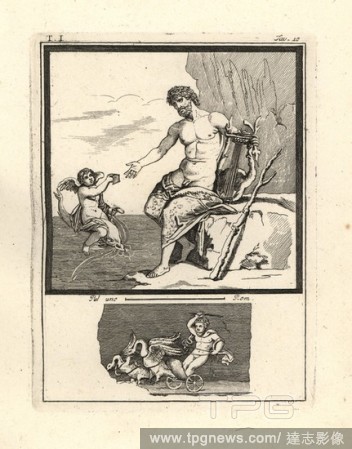
Editorial The Cyclops Polyphemus who fell in love with the nymph Galatea. He is shown with two eyes holding a lyre as he receives a message from Galatea brought by a Genius or cupid on a dolphin. The vignette below shows a cupid in a small carriage driven by swa...
- 2020-12-01
- 1
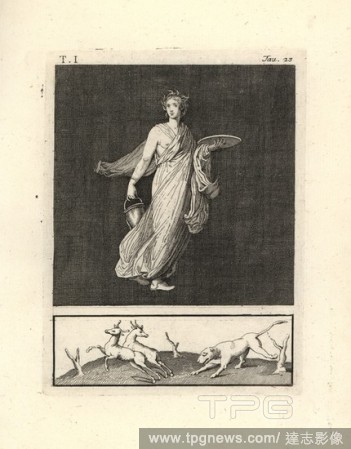
Editorial Painting removed from a wall of a room, possibly a triclinium or dining room, in a house in Pompeii in 1749. It shows a Cernophores dancer with basket and plate, a crown of wheat, and a fine white robe with sandals. The Cernophores imitated religious d...
- 2020-12-01
- 4
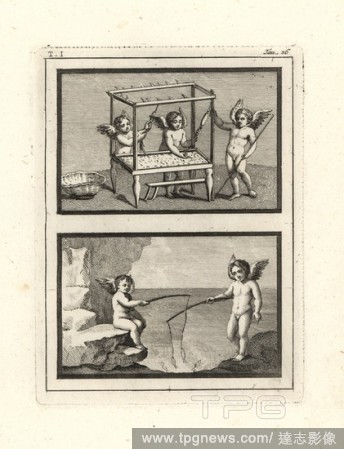
Editorial Vignettes of Cupids playing and working. Above, according to Visconti, this curious image shows three cupids making Vittae, small scalloped ribbons to decorate temples, victims and religious objects. Below, two genii enjoy fishing with rods. Copperplat...
- 2020-12-01
- 1
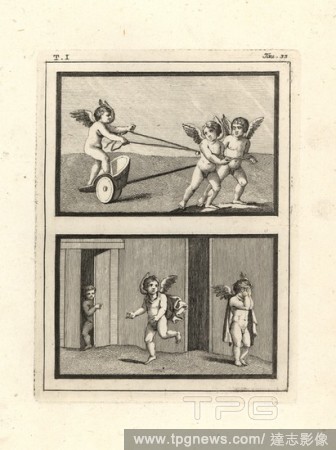
Editorial Two vignettes of Cupids or genii playing ancient games. Above, three cupids play on a two-wheeled chariot or Birotum as if rehearsing for the Circus. Below, three genii play a game of hide and seek. Copperplate engraved by Tommaso Piroli from his own "...
- 2020-12-01
- 1
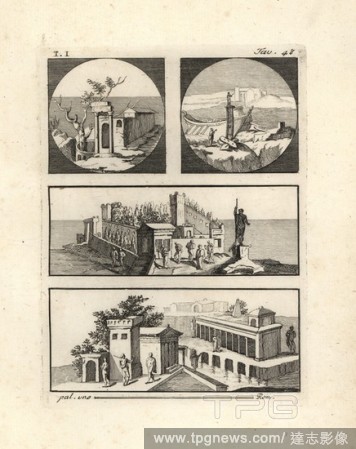
Editorial The top left shows a landscape with two columns supporting an architrave in front of ruins, and the top right shows a statue that could be a Leucothea, with a ship at sea and a country house. The central panel shows a magnificent country house, with mu...
- 2020-12-01
- 2
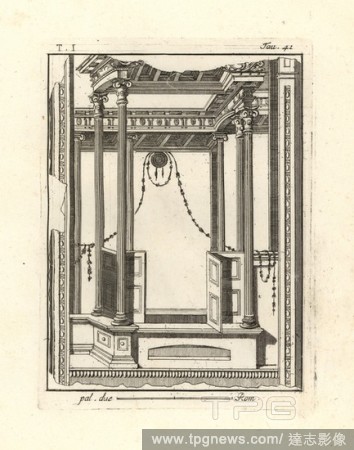
Editorial Wall painting excavated in Resina showing a portal, with candelabra-shaped columns, chest-high walls or plutei, cornices and portico. The tympanum or shield decorated with a garland could indicate that it is a temple portal. Copperplate engraved by Tom...
- 2020-12-01
- 3
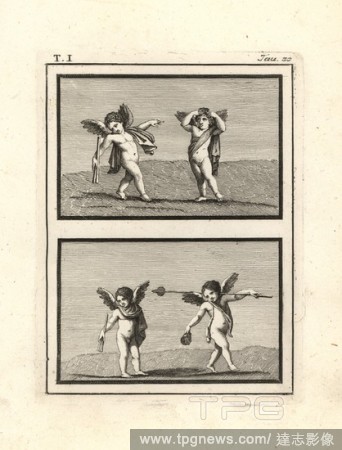
Editorial Painting of cupids or genii playing discovered in Resina in 1748. The cupids carry split reeds, musical instruments, long scepters and crowns of myrtle. Copperplate engraved by Tommaso Piroli from his own "Antichita di Ercolano" (Antiquities of Hercula...
- 2020-12-01
- 1
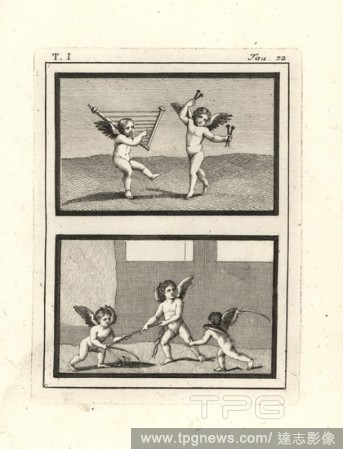
Editorial Cupids or genii playing music and games. Above, cupids dancing while playing a 10-string lyre and crotales, a bronze percussion instrument. Below, three cupids play a game of pulling a stake from the ground. Copperplate engraved by Tommaso Piroli from ...
- 2020-12-01
- 1

Editorial Two seats for Venus and Mars found in Resina in 1748. Two genii or cupids decorate the seat of Venus above with myrtle and a sceptre, while two genii decorate the seat of Mars below with a helmet, shield and laurel. Copperplate engraved by Tommaso Piro...
- 2020-12-01
- 1
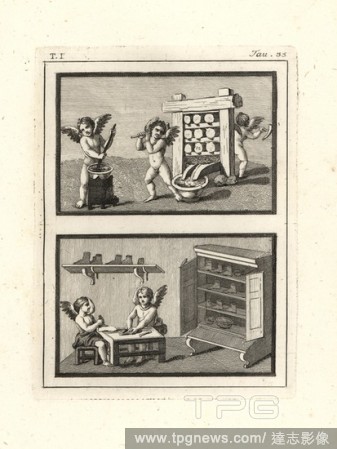
Editorial Vignettes of Cupids playing at trades or professions. Above, two Cupids or genii imitate Capulatores or grape pressers while another stirs grape juice over a stove. Below, two Cupids make leather shoes in a shoemakers' shop with lasts and tools. Copper...
- 2020-12-01
- 1
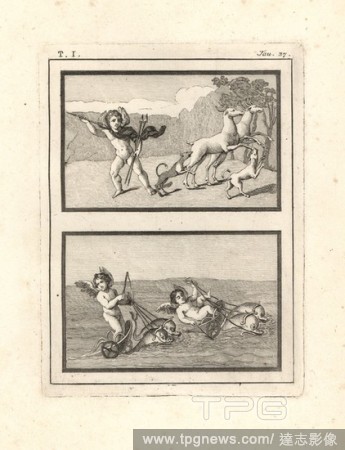
Editorial Vignettes of cupids or genii playing at hunting and racing. Above, a dynamic depiction of the Genius of the Hunt with spears, dogs and stags. Below, two genii race chariots pulled by dolphins in the sea - one seems to be asleep like the famous ferryman...
- 2020-12-01
- 1
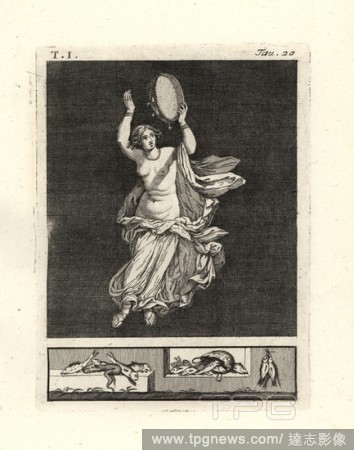
Editorial Painting removed from a wall of a room, possibly a triclinium or dining room, in a house in Pompeii in 1749. It shows a bacchant dancer striking a tympanum or tambourine with her hand. She wears a necklace and bracelets, and a fine robe in white lined ...
- 2020-11-26
- 1
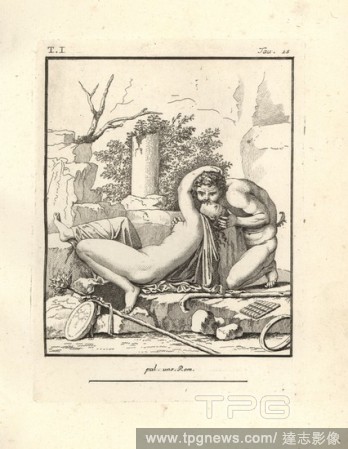
Editorial A bacchant surprised by a faun in a desolate mountain spot. At the faun's feet are his curved stick or pedum, seven-pipe flute or syrinx, and a Rhombus, a percussion instrument like a tambourine. At the bacchant's feet are a sacred staff or thyrsus dec...
- 2020-11-26
- 2
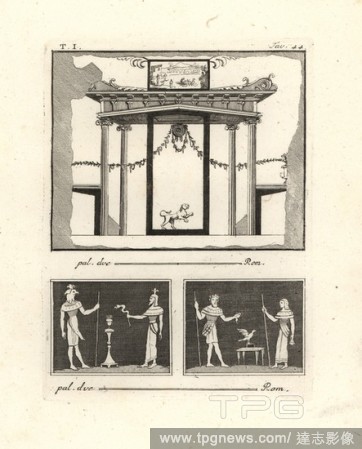
Editorial Architectural painting of a vestibule. The columns have Ionic capitals but no bases, and the cornice has ornamental corbels and triglyphs closer to the Doric. Below are two vignettes showing Egyptian gods: Osiris and priest and snake, and Osiris and Is...
- 2020-11-26
- 1
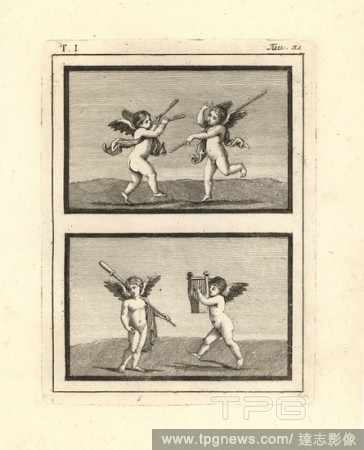
Editorial Painting of cupids or genii playing discovered in Resina in 1748. The cupids play music on various instruments, such as a lyre and keyed flute, while other dance with long scepters. Copperplate engraved by Tommaso Piroli from his own "Antichita di Erco...
- 2020-11-26
- 1
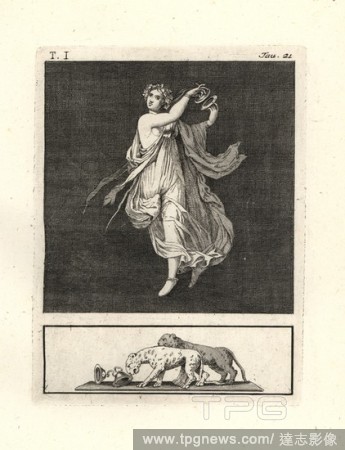
Editorial Painting removed from a wall of a room, possibly a triclinium or dining room, in a house in Pompeii in 1749. It shows a bacchant dancer striking cymbals together. She wears a wreath of ivy, a necklace and bracelets, and a fine blue robe covered with an...
- 2020-11-26
- 2

Editorial Perhaps this is the moment Iphigenia recognizes Orestes in Euripides' "Iphigenia in Aulis"? The painting shows a pensive Orestes, his sister Iphigenia, his friend Pylades, King Thoas and a chorus of young and old women. Behind them is a statue of Diana...
- 2020-09-28
- 1
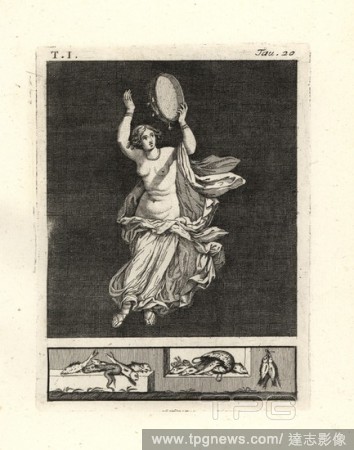
Editorial Painting removed from a wall of a room, possibly a triclinium or dining room, in a house in Pompeii in 1749. It shows a bacchant dancer striking a tympanum or tambourine with her hand. She wears a necklace and bracelets, and a fine robe in white lined ...
- 2020-09-28
- 1
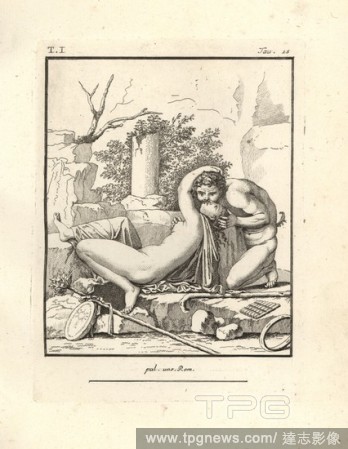
Editorial A bacchant surprised by a faun in a desolate mountain spot. At the faun's feet are his curved stick or pedum, seven-pipe flute or syrinx, and a Rhombus, a percussion instrument like a tambourine. At the bacchant's feet are a sacred staff or thyrsus dec...
- 2020-09-28
- 3
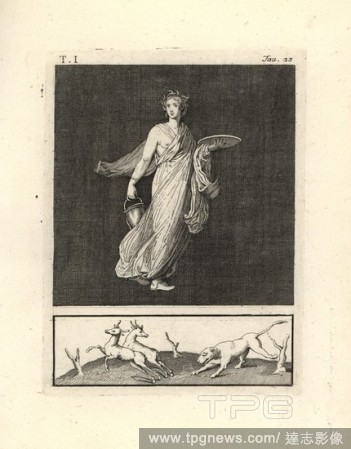
Editorial Painting removed from a wall of a room, possibly a triclinium or dining room, in a house in Pompeii in 1749. It shows a Cernophores dancer with basket and plate, a crown of wheat, and a fine white robe with sandals. The Cernophores imitated religious d...
- 2020-09-28
- 4
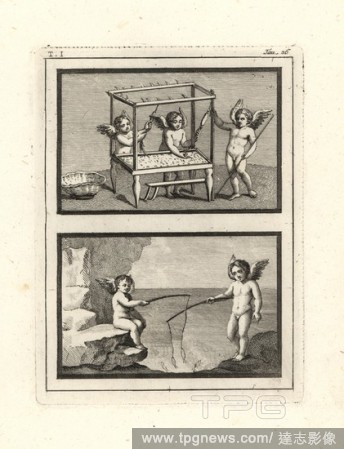
Editorial Vignettes of Cupids playing and working. Above, according to Visconti, this curious image shows three cupids making Vittae, small scalloped ribbons to decorate temples, victims and religious objects. Below, two genii enjoy fishing with rods. Copperplat...
- 2020-09-28
- 1
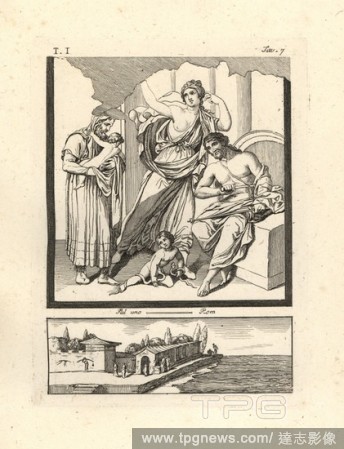
Editorial The painting shows Hercules as a baby killing two snakes with his bare hands to protect his twin brother Iphicles, while his mother Alcmene watches distraught. Amphitryon, a prince of Argos, clutches his sword, while a teacher in slave robes clutches t...
- 2020-09-28
- 4

Editorial While some ancient authorities believe this to be a portrait of Dido as described by Virgil, modern opinion holds that this is Melpomene, the Muse of Tragedy, wearing Carthaginian costume, holding a sword in a strange sheath with a mushroom-shaped tip....
- 2020-09-28
- 4
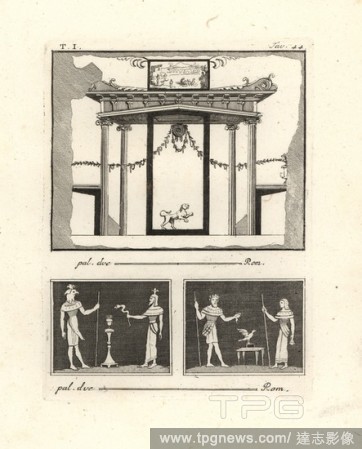
Editorial Architectural painting of a vestibule. The columns have Ionic capitals but no bases, and the cornice has ornamental corbels and triglyphs closer to the Doric. Below are two vignettes showing Egyptian gods: Osiris and priest and snake, and Osiris and Is...
- 2020-09-28
- 2
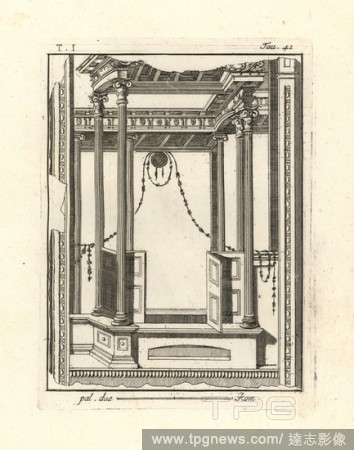
Editorial Wall painting excavated in Resina showing a portal, with candelabra-shaped columns, chest-high walls or plutei, cornices and portico. The tympanum or shield decorated with a garland could indicate that it is a temple portal. Copperplate engraved by Tom...
- 2020-09-28
- 2

Editorial Painting of cupids or genii playing discovered in Resina in 1748. The cupids carry split reeds, musical instruments, long scepters and crowns of myrtle. Copperplate engraved by Tommaso Piroli from his own "Antichita di Ercolano" (Antiquities of Hercula...
- 2020-09-28
- 1

Editorial Cupids or genii playing music and games. Above, cupids dancing while playing a 10-string lyre and crotales, a bronze percussion instrument. Below, three cupids play a game of pulling a stake from the ground. Copperplate engraved by Tommaso Piroli from ...
- 2020-09-28
- 1

Editorial An old faun or Silenus with bushy beard struggles with a Hermaphrodite in this excellent Bacchanalian subject excavated at Resina. Copperplate engraved by Tommaso Piroli from his own "Antichita di Ercolano" (Antiquities of Herculaneum), Rome, 1789. Ita...
- 2020-09-28
- 2
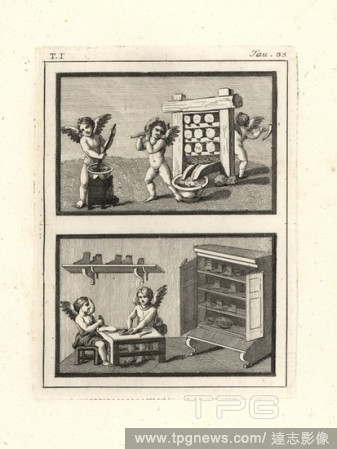
Editorial Vignettes of Cupids playing at trades or professions. Above, two Cupids or genii imitate Capulatores or grape pressers while another stirs grape juice over a stove. Below, two Cupids make leather shoes in a shoemakers' shop with lasts and tools. Copper...
- 2020-09-28
- 1
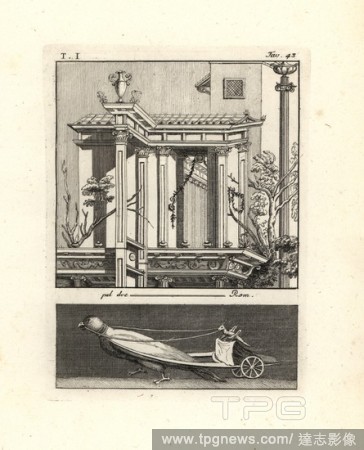
Editorial Architectural painting of an Ionic portico, with a cornice decorated with dolphins and tritons, and an entablature with vase. Perhaps a Coenaculum, the upper room on a country house. Vignette below shows a parrot pulling a cricket in a chariot. Copperp...
- 2020-09-28
- 2
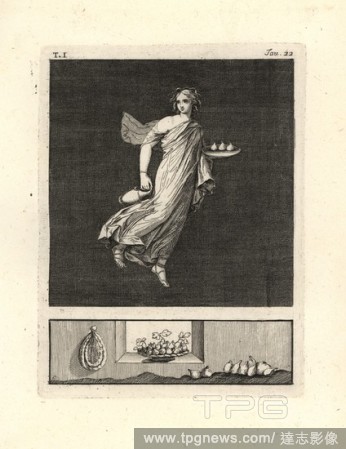
Editorial Painting removed from a wall of a room, possibly a triclinium or dining room, in a house in Pompeii in 1749. It shows a Naiad, a follower of Bacchus, carrying a vase and a round plate with three figs. She wears reeds in her hair, a gold bracelet, and a...
- 2020-09-28
- 3
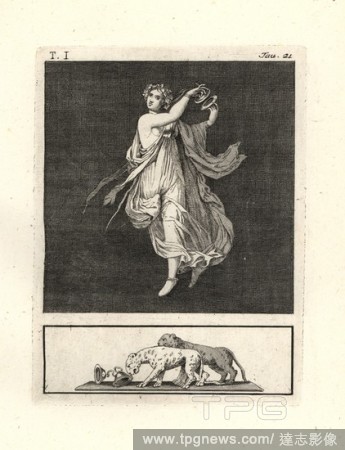
Editorial Painting removed from a wall of a room, possibly a triclinium or dining room, in a house in Pompeii in 1749. It shows a bacchant dancer striking cymbals together. She wears a wreath of ivy, a necklace and bracelets, and a fine blue robe covered with an...
- 2020-09-28
- 2

Editorial Two vignettes at top showing trees surmounted by gold shields with the head of the Medusa. At the foot of one tree is a Dryad with a hatchet, the attribute of the guardian nymph of the forest. The two landscapes below show Nile scenes in Egypt with Anu...
- 2019-11-19
- 1

Editorial Last Judgment, after Michelangelo.
- 2019-11-18
- 1

Editorial Last Judgment, after Michelangelo.
- 2019-02-22
- 1
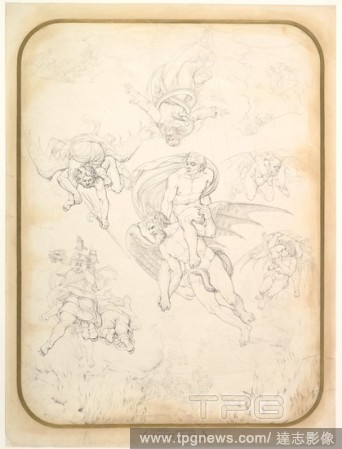
Editorial Last Judgment, after Michelangelo.
- 2019-02-01
- 1
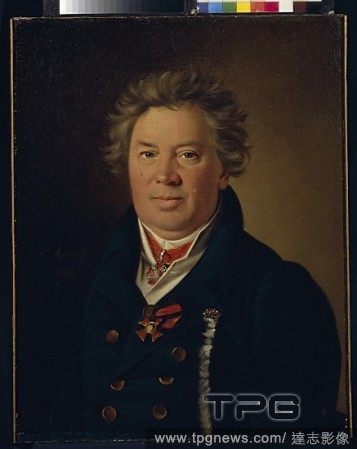
Editorial Portrait of the architect Fyodor Kirillovich Sokolov (1752-1824).
- 2019-01-24
- 1

Editorial Perhaps this is the moment Iphigenia recognizes Orestes in Euripides' "Iphigenia in Aulis"? The painting shows a pensive Orestes, his sister Iphigenia, his friend Pylades, King Thoas and a chorus of young and old women. Behind them is a statue of Diana...
- 2019-01-24
- 1
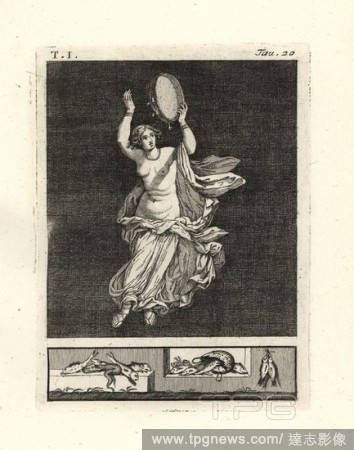
Editorial Painting removed from a wall of a room, possibly a triclinium or dining room, in a house in Pompeii in 1749. It shows a bacchant dancer striking a tympanum or tambourine with her hand. She wears a necklace and bracelets, and a fine robe in white lined ...
- 2019-01-24
- 1
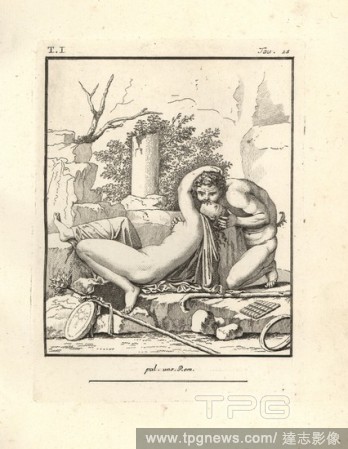
Editorial A bacchant surprised by a faun in a desolate mountain spot. At the faun's feet are his curved stick or pedum, seven-pipe flute or syrinx, and a Rhombus, a percussion instrument like a tambourine. At the bacchant's feet are a sacred staff or thyrsus dec...
- 2019-01-24
- 4
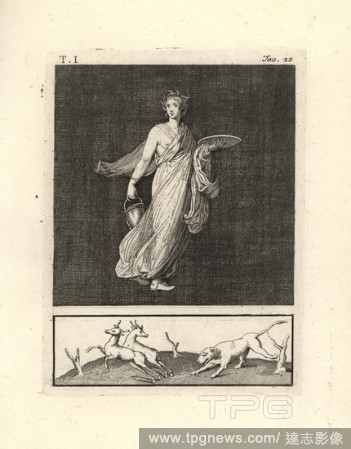
Editorial Painting removed from a wall of a room, possibly a triclinium or dining room, in a house in Pompeii in 1749. It shows a Cernophores dancer with basket and plate, a crown of wheat, and a fine white robe with sandals. The Cernophores imitated religious d...
- 2019-01-24
- 4
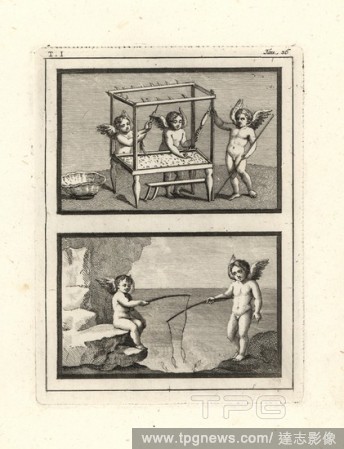
Editorial Vignettes of Cupids playing and working. Above, according to Visconti, this curious image shows three cupids making Vittae, small scalloped ribbons to decorate temples, victims and religious objects. Below, two genii enjoy fishing with rods. Copperplat...
- 2019-01-24
- 1

Editorial The painting shows Hercules as a baby killing two snakes with his bare hands to protect his twin brother Iphicles, while his mother Alcmene watches distraught. Amphitryon, a prince of Argos, clutches his sword, while a teacher in slave robes clutches t...
- 2019-01-24
- 4
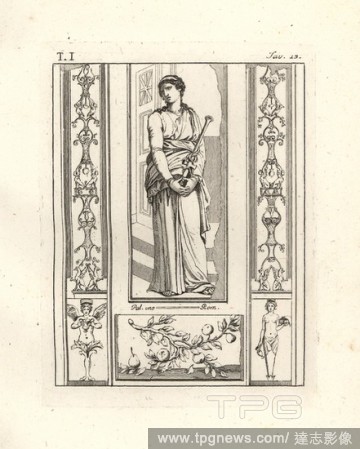
Editorial While some ancient authorities believe this to be a portrait of Dido as described by Virgil, modern opinion holds that this is Melpomene, the Muse of Tragedy, wearing Carthaginian costume, holding a sword in a strange sheath with a mushroom-shaped tip....
- 2019-01-24
- 4
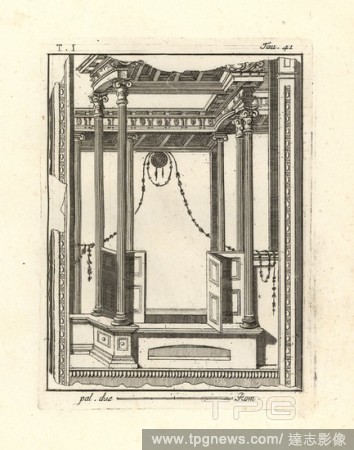
Editorial Wall painting excavated in Resina showing a portal, with candelabra-shaped columns, chest-high walls or plutei, cornices and portico. The tympanum or shield decorated with a garland could indicate that it is a temple portal. Copperplate engraved by Tom...
- 2019-01-24
- 4
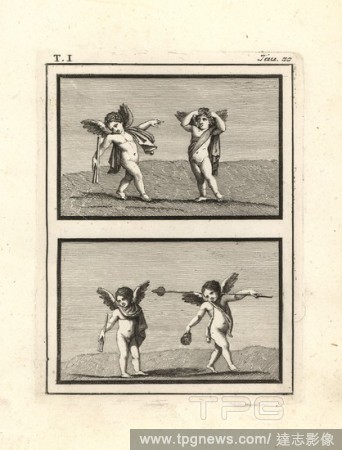
Editorial Painting of cupids or genii playing discovered in Resina in 1748. The cupids carry split reeds, musical instruments, long scepters and crowns of myrtle. Copperplate engraved by Tommaso Piroli from his own "Antichita di Ercolano" (Antiquities of Hercula...
- 2019-01-24
- 1
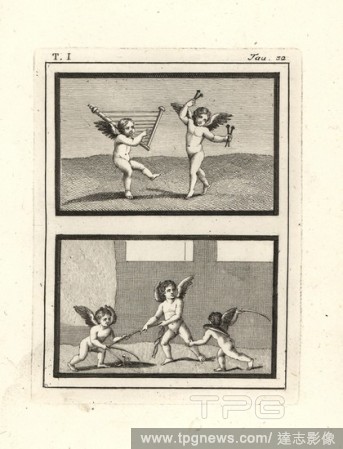
Editorial Cupids or genii playing music and games. Above, cupids dancing while playing a 10-string lyre and crotales, a bronze percussion instrument. Below, three cupids play a game of pulling a stake from the ground. Copperplate engraved by Tommaso Piroli from ...
- 2019-01-24
- 1
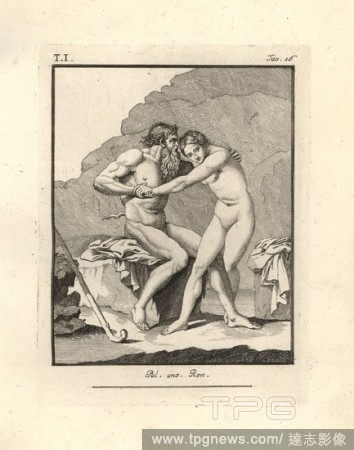
Editorial An old faun or Silenus with bushy beard struggles with a Hermaphrodite in this excellent Bacchanalian subject excavated at Resina. Copperplate engraved by Tommaso Piroli from his own "Antichita di Ercolano" (Antiquities of Herculaneum), Rome, 1789. Ita...
- 2019-01-24
- 2

Editorial Vignettes of Cupids playing at trades or professions. Above, two Cupids or genii imitate Capulatores or grape pressers while another stirs grape juice over a stove. Below, two Cupids make leather shoes in a shoemakers' shop with lasts and tools. Copper...
- 2019-01-24
- 1
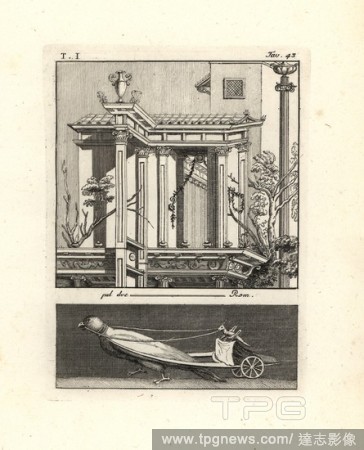
Editorial Architectural painting of an Ionic portico, with a cornice decorated with dolphins and tritons, and an entablature with vase. Perhaps a Coenaculum, the upper room on a country house. Vignette below shows a parrot pulling a cricket in a chariot. Copperp...
- 2019-01-24
- 2

Editorial Painting removed from a wall of a room, possibly a triclinium or dining room, in a house in Pompeii in 1749. It shows a Naiad, a follower of Bacchus, carrying a vase and a round plate with three figs. She wears reeds in her hair, a gold bracelet, and a...
- 2019-01-24
- 3
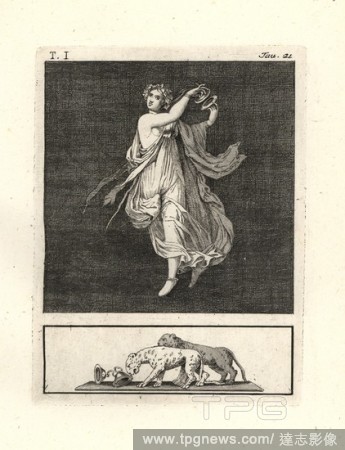
Editorial Painting removed from a wall of a room, possibly a triclinium or dining room, in a house in Pompeii in 1749. It shows a bacchant dancer striking cymbals together. She wears a wreath of ivy, a necklace and bracelets, and a fine blue robe covered with an...
- 2019-01-24
- 2
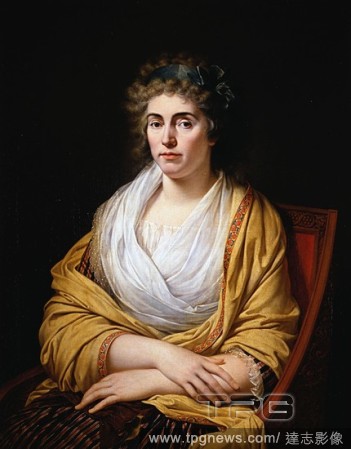
Editorial Portrait of Princess Louise of Stolberg-Gedern (1752-1824), Countess of Albany.
- 2019-01-23
- 1

Editorial Perhaps this is the moment Iphigenia recognizes Orestes in Euripides' "Iphigenia in Aulis"? The painting shows a pensive Orestes, his sister Iphigenia, his friend Pylades, King Thoas and a chorus of young and old women. Behind them is a statue of Diana...
- 2018-08-21
- 1
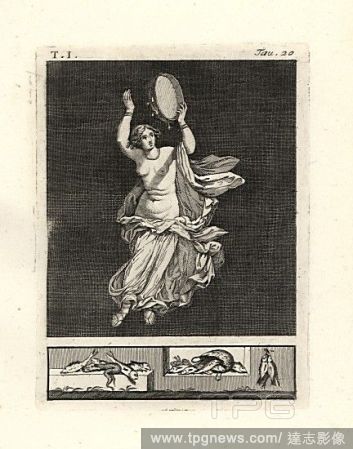
Editorial Painting removed from a wall of a room, possibly a triclinium or dining room, in a house in Pompeii in 1749. It shows a bacchant dancer striking a tympanum or tambourine with her hand. She wears a necklace and bracelets, and a fine robe in white lined ...
- 2018-08-21
- 1
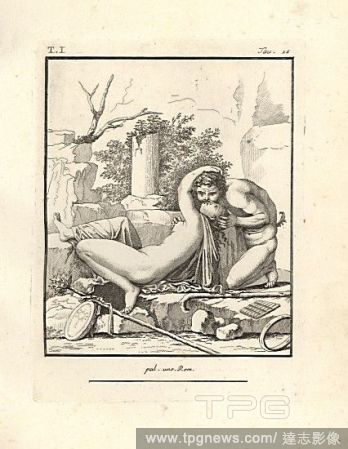
Editorial A bacchant surprised by a faun in a desolate mountain spot. At the faun's feet are his curved stick or pedum, seven-pipe flute or syrinx, and a Rhombus, a percussion instrument like a tambourine. At the bacchant's feet are a sacred staff or thyrsus dec...
- 2018-08-21
- 4

Editorial Painting removed from a wall of a room, possibly a triclinium or dining room, in a house in Pompeii in 1749. It shows a Cernophores dancer with basket and plate, a crown of wheat, and a fine white robe with sandals. The Cernophores imitated religious d...
- 2018-08-21
- 4

Editorial Vignettes of Cupids playing and working. Above, according to Visconti, this curious image shows three cupids making Vittae, small scalloped ribbons to decorate temples, victims and religious objects. Below, two genii enjoy fishing with rods. Copperplat...
- 2018-08-21
- 1

Editorial The painting shows Hercules as a baby killing two snakes with his bare hands to protect his twin brother Iphicles, while his mother Alcmene watches distraught. Amphitryon, a prince of Argos, clutches his sword, while a teacher in slave robes clutches t...
- 2018-08-21
- 4

Editorial While some ancient authorities believe this to be a portrait of Dido as described by Virgil, modern opinion holds that this is Melpomene, the Muse of Tragedy, wearing Carthaginian costume, holding a sword in a strange sheath with a mushroom-shaped tip....
- 2018-08-21
- 4
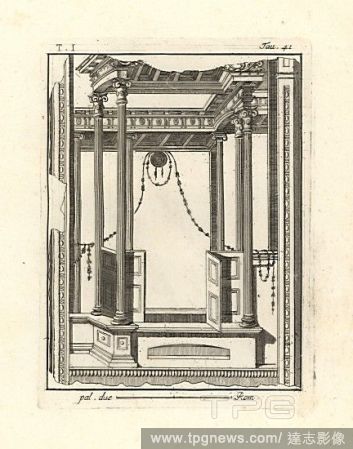
Editorial Wall painting excavated in Resina showing a portal, with candelabra-shaped columns, chest-high walls or plutei, cornices and portico. The tympanum or shield decorated with a garland could indicate that it is a temple portal. Copperplate engraved by Tom...
- 2018-08-21
- 4
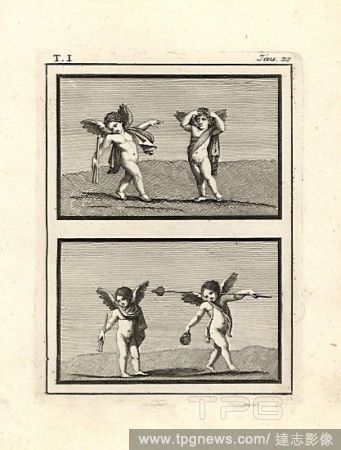
Editorial Painting of cupids or genii playing discovered in Resina in 1748. The cupids carry split reeds, musical instruments, long scepters and crowns of myrtle. Copperplate engraved by Tommaso Piroli from his own "Antichita di Ercolano" (Antiquities of Hercula...
- 2018-08-21
- 1
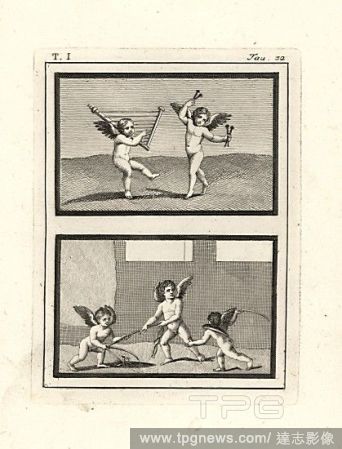
Editorial Cupids or genii playing music and games. Above, cupids dancing while playing a 10-string lyre and crotales, a bronze percussion instrument. Below, three cupids play a game of pulling a stake from the ground. Copperplate engraved by Tommaso Piroli from ...
- 2018-08-21
- 1
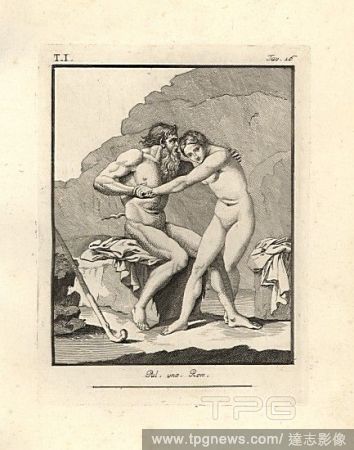
Editorial An old faun or Silenus with bushy beard struggles with a Hermaphrodite in this excellent Bacchanalian subject excavated at Resina. Copperplate engraved by Tommaso Piroli from his own "Antichita di Ercolano" (Antiquities of Herculaneum), Rome, 1789. Ita...
- 2018-08-21
- 2
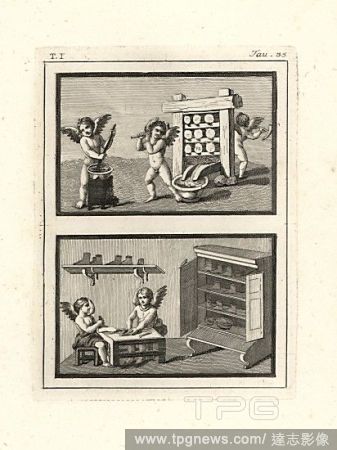
Editorial Vignettes of Cupids playing at trades or professions. Above, two Cupids or genii imitate Capulatores or grape pressers while another stirs grape juice over a stove. Below, two Cupids make leather shoes in a shoemakers' shop with lasts and tools. Copper...
- 2018-08-21
- 1
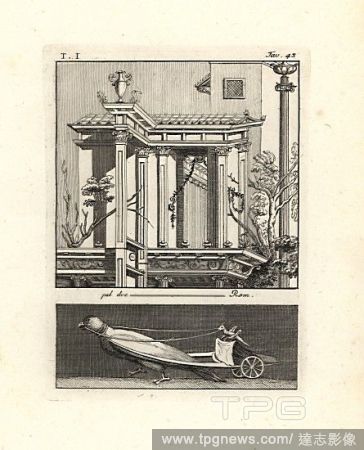
Editorial Architectural painting of an Ionic portico, with a cornice decorated with dolphins and tritons, and an entablature with vase. Perhaps a Coenaculum, the upper room on a country house. Vignette below shows a parrot pulling a cricket in a chariot. Copperp...
- 2018-08-21
- 2
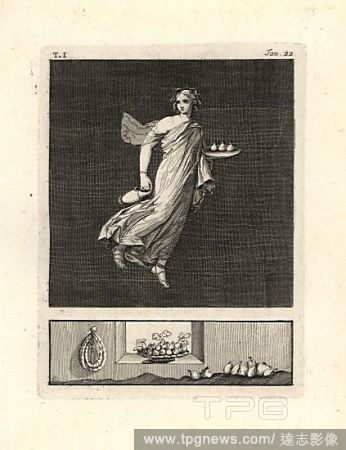
Editorial Painting removed from a wall of a room, possibly a triclinium or dining room, in a house in Pompeii in 1749. It shows a Naiad, a follower of Bacchus, carrying a vase and a round plate with three figs. She wears reeds in her hair, a gold bracelet, and a...
- 2018-08-21
- 3

Editorial Painting removed from a wall of a room, possibly a triclinium or dining room, in a house in Pompeii in 1749. It shows a bacchant dancer striking cymbals together. She wears a wreath of ivy, a necklace and bracelets, and a fine blue robe covered with an...
- 2018-08-21
- 2
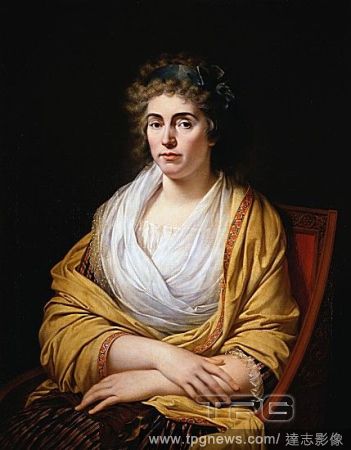
Editorial Portrait of Princess Louise of Stolberg-Gedern (1752-1824), Countess of Albany.
- 2018-08-09
- 1

Editorial Last Judgment, after Michelangelo.
- 2018-08-08
- 1
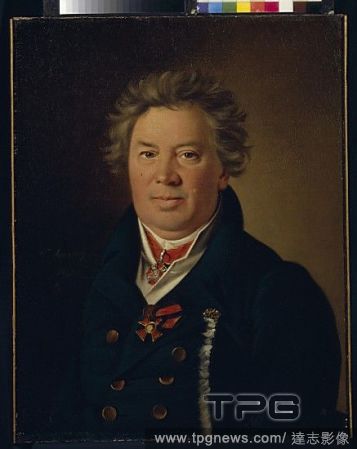
Editorial Portrait of the architect Fyodor Kirillovich Sokolov (1752-1824).
- 2018-07-31
- 1
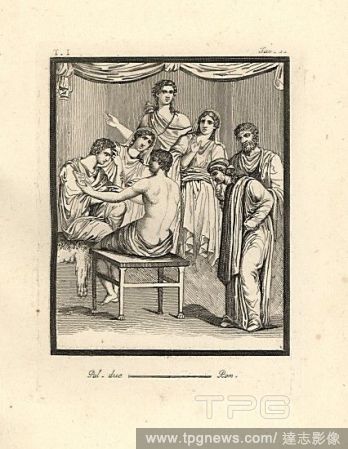
Editorial Perhaps this is the moment Iphigenia recognizes Orestes in Euripides' "Iphigenia in Aulis"? The painting shows a pensive Orestes, his sister Iphigenia, his friend Pylades, King Thoas and a chorus of young and old women. Behind them is a statue of Diana...
- 2018-07-24
- 1
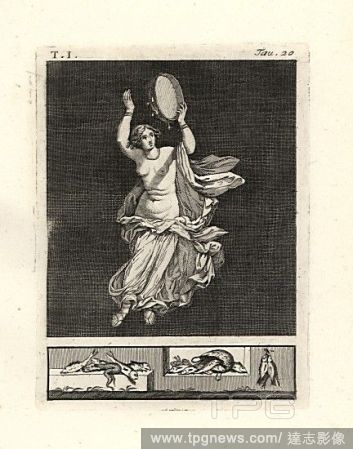
Editorial Painting removed from a wall of a room, possibly a triclinium or dining room, in a house in Pompeii in 1749. It shows a bacchant dancer striking a tympanum or tambourine with her hand. She wears a necklace and bracelets, and a fine robe in white lined ...
- 2018-07-24
- 1

Editorial A bacchant surprised by a faun in a desolate mountain spot. At the faun's feet are his curved stick or pedum, seven-pipe flute or syrinx, and a Rhombus, a percussion instrument like a tambourine. At the bacchant's feet are a sacred staff or thyrsus dec...
- 2018-07-24
- 4

Editorial Painting removed from a wall of a room, possibly a triclinium or dining room, in a house in Pompeii in 1749. It shows a Cernophores dancer with basket and plate, a crown of wheat, and a fine white robe with sandals. The Cernophores imitated religious d...
- 2018-07-24
- 4
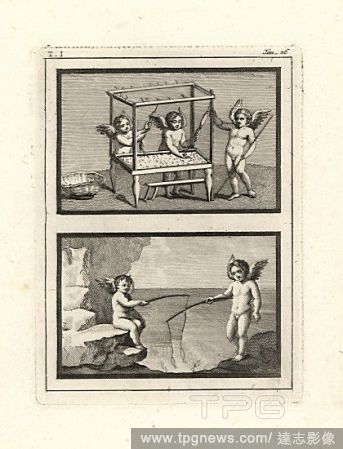
Editorial Vignettes of Cupids playing and working. Above, according to Visconti, this curious image shows three cupids making Vittae, small scalloped ribbons to decorate temples, victims and religious objects. Below, two genii enjoy fishing with rods. Copperplat...
- 2018-07-24
- 1
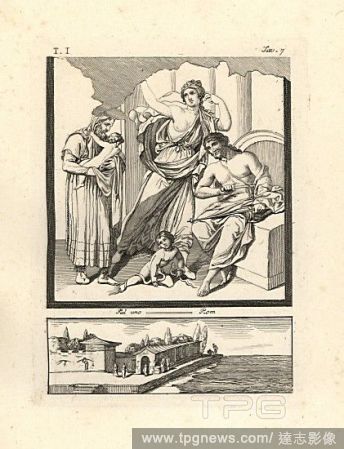
Editorial The painting shows Hercules as a baby killing two snakes with his bare hands to protect his twin brother Iphicles, while his mother Alcmene watches distraught. Amphitryon, a prince of Argos, clutches his sword, while a teacher in slave robes clutches t...
- 2018-07-24
- 4
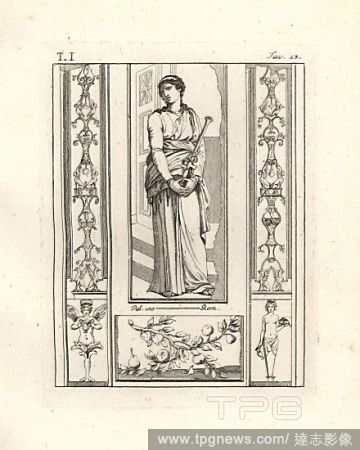
Editorial While some ancient authorities believe this to be a portrait of Dido as described by Virgil, modern opinion holds that this is Melpomene, the Muse of Tragedy, wearing Carthaginian costume, holding a sword in a strange sheath with a mushroom-shaped tip....
- 2018-07-24
- 4
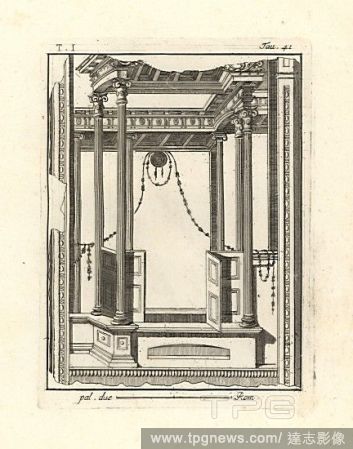
Editorial Wall painting excavated in Resina showing a portal, with candelabra-shaped columns, chest-high walls or plutei, cornices and portico. The tympanum or shield decorated with a garland could indicate that it is a temple portal. Copperplate engraved by Tom...
- 2018-07-24
- 4
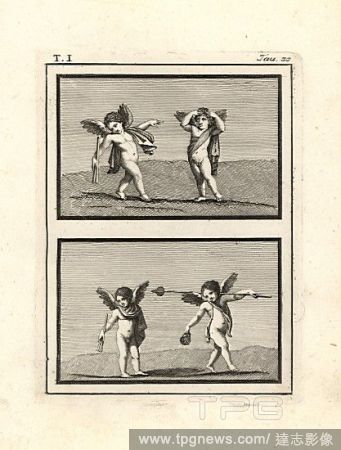
Editorial Painting of cupids or genii playing discovered in Resina in 1748. The cupids carry split reeds, musical instruments, long scepters and crowns of myrtle. Copperplate engraved by Tommaso Piroli from his own "Antichita di Ercolano" (Antiquities of Hercula...
- 2018-07-24
- 1

Editorial Cupids or genii playing music and games. Above, cupids dancing while playing a 10-string lyre and crotales, a bronze percussion instrument. Below, three cupids play a game of pulling a stake from the ground. Copperplate engraved by Tommaso Piroli from ...
- 2018-07-24
- 1
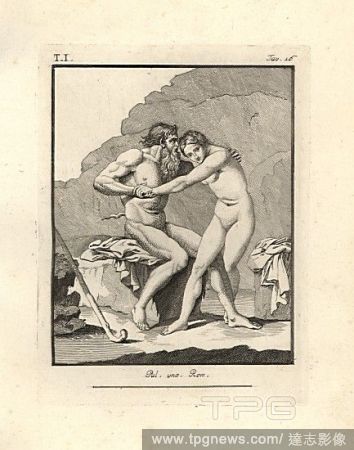
Editorial An old faun or Silenus with bushy beard struggles with a Hermaphrodite in this excellent Bacchanalian subject excavated at Resina. Copperplate engraved by Tommaso Piroli from his own "Antichita di Ercolano" (Antiquities of Herculaneum), Rome, 1789. Ita...
- 2018-07-24
- 2

Editorial Vignettes of Cupids playing at trades or professions. Above, two Cupids or genii imitate Capulatores or grape pressers while another stirs grape juice over a stove. Below, two Cupids make leather shoes in a shoemakers' shop with lasts and tools. Copper...
- 2018-07-24
- 1
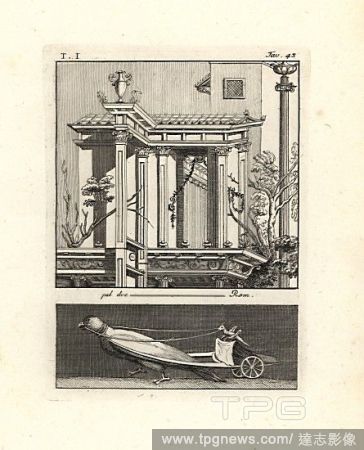
Editorial Architectural painting of an Ionic portico, with a cornice decorated with dolphins and tritons, and an entablature with vase. Perhaps a Coenaculum, the upper room on a country house. Vignette below shows a parrot pulling a cricket in a chariot. Copperp...
- 2018-07-24
- 2

Editorial Painting removed from a wall of a room, possibly a triclinium or dining room, in a house in Pompeii in 1749. It shows a bacchant dancer striking cymbals together. She wears a wreath of ivy, a necklace and bracelets, and a fine blue robe covered with an...
- 2018-07-24
- 2
 Loading
Loading 